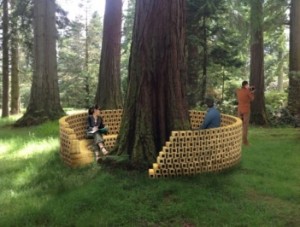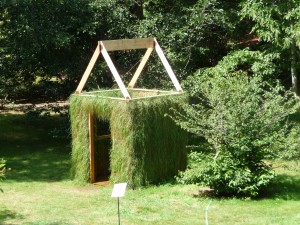What Good Is A Museum? Secret Shelters at the Heritage Museums and Gardens
Today we bring you an article by Kathryn Sodaitis, currently a Tufts student in the Museum Studies certificate program. For Museums Today: Mission and Function, the foundation course required for all Museum Studies students, students read Adam Gopnik’s “The Mindful Museum” and use it to create a discussion around the question, “What Good Is A Museum?”.
What makes some exhibitions more memorable than others? A meaningful experience can delight and surprise us, and motivates us to return. This summer, I visited Heritage Museums and Gardens in Sandwich, MA where I had such an experience. Heritage has a small permanent collection of Americana–antique cars, scrimshaw, folk art, and an antique carousel–all located in several buildings scattered throughout the grounds, and a special exhibition gallery, which houses new exhibits each summer. But it is the gardens that make Heritage Museums unique. They span 100 acres and include paved walking paths as well as unusual features such as a flume waterfall installation, a maze, and a labyrinth. Each season, different artists are invited to build temporary installations.
Heritage offers its visitors a specific type of outdoor experience, merging the natural world with creative works. It is these outdoor installations that offer a different experience of time and place. This type of work requires full presence in order to engage with the art.
The pieces I encountered on this trip were part of a temporary exhibition entitled Secret Shelters. Each piece is placed into the land, bringing your attention to a specific location: surrounding a tree, set inside a grassy valley, up on a hill. Not only do you engage with the artwork, but you engage with the physical landscape. The installations set into the scale of the land allow you to fully experience the art with your whole body; art is experienced on the human scale and in relation to the vast landscape.

One of these exhibits, titled “Outside-In,” by artist Yugon Kim is a circular bench made of recycled waste wood surrounding a tree. From afar, the bench itself is enticing to the weary visitor, but as you approach, you notice how it is put together. Many hollow cubes of wood, stacked and fastened together make up the structure of the bench which encircles the tree. An opening on the far side requires the viewer to walk around the tree before entering and sitting. This tree, unnoticed and unseen before the construction of the bench, now becomes an object of significance. The texture of the bark, the shade of its canopy, the diameter of its trunk are now acknowledged and appreciated. In the shadow of this looming tree, standing in this place only because of the artistic intention, I realize I am just a part of the larger artistic experience. The artist’s contribution to this moment is felt.
The next piece I enountered took a bit of work. I wandered off the paved pathway, through the vast Hydrangea Garden into a grassy meadow down into a valley. I might not have seen the piece titled “Eaves/Grass” by Joel Reider made out of living grass had the structure not jutted out in its rectangular and pointed house-like shape, complete with a front door and side window. Constructed out of wood supports and covered with sod, the grass house sat comfortably into its landscape. Its attempt at

camouflage unsuccessful (this is an art piece after all), it struck me as something that shouldn’t exist (but it did). Once inside, I saw the square mirror, the same size and shape of the window on the opposing wall. Looking out the window, I saw the landscape. Looking into the mirror, I saw myself in the very same landscape. This hidden gem, both seen and unseen, tucked into a secluded space, yet deliberately sought after, reminded me of what I most appreciate in a museum experience: the joy of surprise. Where else can we go expecting and yet still experiencing surprise? The artists bring the experience of the (sometimes) absurd into existence, but the viewers may not know to look for them without the presence of the museum.
These landscape pieces, especially the temporary ones, would not exist without the ability of the museum to create a space that brings artwork and viewers together. Museums create a space for artistic encounters between artists, objects, and viewers. These encounters can be emotional-visceral experiences, bringing the viewer to full attention, awakening feelings of surprise and delight. This might be described as the “mindful museum” experience, one that is personal, place-centered, and belonging to the “here and now”.
Here is a link to the museum’s website, which details the exhibition, Secret Shelters.
Hi Kathryn,
Jan Crocker from the Heritage Museum forwarded me a link to this article. I just want to say I appreciate your mentioning my piece—I’m glad you got to see it.
Best,
Joel Reider
Joel, I’m so glad you saw this. I really enjoyed your piece. It was well worth the journey–what a surprise to find it. Thank you!
Hi Joel,
You will just have to build one in your back yard so I can see it.
A hidden jem
Wonderful,
Avraham Dworsky
I updated the post with a photo of Joel Reider’s work. Thanks for visiting!
Hello Kathryn, thanks for writing about my piece!
You’re welcome-thanks for visiting the blog!